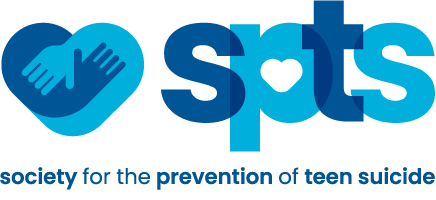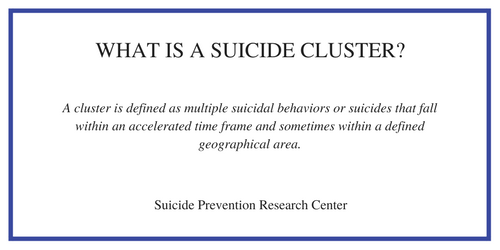Here’s the facts…
When a school experiences the sudden traumatic death of a student, especially when that death is a suicide, it can be hard to imagine that the situation could be any worse. And yet the unfortunate truth is that in some cases other deaths may follow. While one suicide in a school community is devastating enough in itself, when it is followed by a second, the air is often tinged with the apprehension of “who will it be next?” What a school may be experiencing is what is called a ‘suicide cluster’.
The concern about suicide imitation by youth is unfortunately justified. Research has documented that clusters tend to occur among adolescents and young adults under age twenty-four. In 1991, it was estimated that only between 1 and 2 percent of annual suicides occur in clusters; in 2015 that number is estimated to be as high as 10 percent. Research has demonstrated that the occurrence of a single suicide in a community increases the risk of further suicides within that community.
So what’s a school to do if you’re worried you may be experiencing a suicide cluster? Here are some suggestions:
- Try not to get preoccupied with whether the deaths qualify as a ‘cluster’. Focus on your response plan: identifying students who may be at-risk because of their relationships to the deceased or prior vulnerabilities.
- Involve all members of the school community – faculty, staff, and students in particular – in that identification process. Approach it proactively – make a list of the students who have been identified and have a member of your school resource staff talk with them briefly about how they have been affected by the tragic events.
- Consider reaching out to all transfer students, especially if you don’t know much about their history. Transitions are one of the risk factors for suicide, so these students have an added vulnerability.
- Create a short form to document that interaction that includes:
- Name of the student
- Reason for reach out (e.g., neighbor, teammate, known mental health history)
- Name of staff member making reach out
- Comments
- Whether parents/guardians are contacted
- Follow-up plan
- If you do decide that some of these students need referrals for additional assessment by mental health professionals, the information on this form can provide a starting point for those interviews.
- Engage all members of the school community, but especially high school students, in monitoring media posts and identify a central point person to whom all worrisome information can be funneled.
- Remember that the adults in your school community may also be affected by the deaths so they may need a reach-out as well. Be prepared to offer them a list of community resources for support or mental health assistance.
- Offer suicide prevention information to all your faculty and staff with the goal of providing support and suggesting ways in which they can watch out for each other and the other members of the school community. One of the primary reactions to any death, but especially to multiple losses, is a feeling of helplessness that can interfere with the healing process. By suggesting ways that the faculty and staff can provide support to the school community, some of that helplessness can be alleviated.
- Understand that parents and guardians are going to need resources to understand what role they have in helping their children. Often their lack of involvement comes from the fact that they are unaware about how to address their own reactions to suicide, let alone the reactions of their kids.
- Always emphasize resilience and the capacity of the school community to come together to get through challenging times. It’s important to balance the fear and worry that often accompany concerns about additional suicides with the hope that resources have been identified and are available to support the school through this difficult series of events.
- Keep parents and the larger community in the loop about your school’s response strategies. This can help address the common misperception that schools don’t have the plans or resources to help students and their families in times of traumatic loss events.
- Communicate with other schools in your district, including the nonpublic schools, to share information and resources. Remember, tragedies do not respect school boundaries so the impact from these losses may be larger than what you are experiencing in your local community.
- Reach out to your local mental health resources and key community stakeholders to involve the larger community not just in the problem but in the solution. This will take some of the burden off the school and demonstrate that the community has an important role to play in management of this crisis.
- Recognize this isn’t going to go away quickly! Contagion does not end after the death of the most recent student and it is critically important to continue to keep vulnerable students on the school’s radar at least through the end of the school year and at significant events like the anniversary of the death and the birthday of the deceased (s). And even when a school and community do everything they can proactively to prevent another suicide, sometimes the worst does happen, and another student takes his/her life.
Three things to avoid are:
- Being reactive. Don’t sit and wait until something happens at your school to review your policies and protocols, provide your crisis team members with specific roles, responsibilities, and training, and develop cooperative understandings with your local mental health resources.
- Ignoring what’s happening around you. Clusters do not respect school or geographical boundaries; understand that your school is vulnerable even if you have not had a death.
- Getting discouraged. Clusters DO end- there is lots of evidence to show that’s true- but the day to day vigilance school and community members usually report in the midst of a cluster are emotionally exhausting and draining. That’s why joining with students and community members in activities that reinforce resilience and strength may be one of the best antidotes to the negative energy clusters bring with them.


